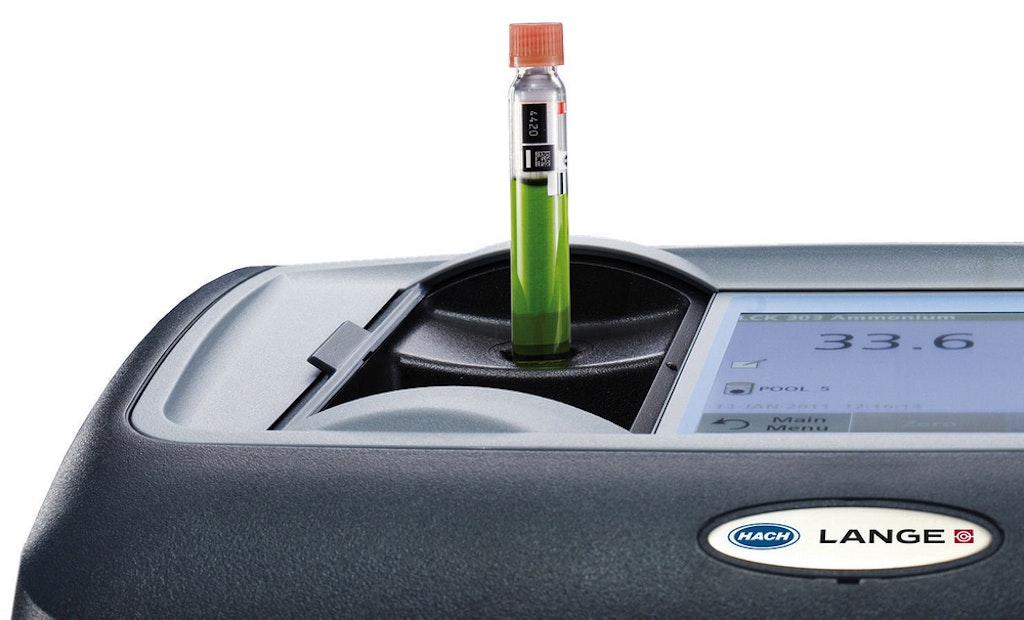Interested in Instrumentation?
Get Instrumentation articles, news and videos right in your inbox! Sign up now.
Instrumentation + Get AlertsThe launch of the world’s first ready-to-use reagent packages for photometric analysis in the 1960s had a substantial effect on environmental analysis. Today Hach LCK Cuvette Tests and photometers are indispensable elements of operational analysis. Innovations such as 10-fold rotational measurement have simplified analysis even further and made it more reliable. Results are recognized provided that Analytical Quality Assurance measures are carried out and documented. The correct processing of used reagents in Hach’s own certified environment center completes the LCK Cuvette Test System.
A good, practical measurement system consists of more than cuvette tests and a photometer. Naturally these products are the basis for operational analysis, but just as important are the appropriate accessories and comprehensive services such as user support by qualified personnel. Correct measurement results are not obtained by chance, but depend on a combination of product quality and workflow quality.
If photometers or reagents are flawed, the user can do everything correctly and still obtain incorrect results. The reverse is also true: Even the best analysis system cannot compensate for flawed handling. Even a correct result will only be accepted if the necessary quality assurance measures are performed and documented. This applies to every measurement system, irrespective of whether it is used for reference analysis or operational analysis.
Quality checks during production
Hach product quality begins even before production: during research and development and in purchasing. Comprehensive checks are carried out on suppliers and raw materials, e.g. the empty glass cuvettes are subjected to high voltage tests to detect material flaws.
Product quality is also a top priority during production. Special machinery is used to ensure the highest quality and reliability, e.g. sorting the caps. Product quality should be totally transparent. Hach ensures this by offering download of Certificates of Analysis on the websites.
Reliability from day one
A special feature of the Hach LCK Cuvette Test System is its focus on practical requirements. Photometer and reagents are coordinated during the development phase, to ensure maximum reliability of the complete analytical procedure. User feedback is taken into account whenever a new test is developed. The result is smart photometers and cuvette tests, whose systematic and simple handling is designed to prevent errors from the start.
Diversity of tests
There are now cuvette tests for more than 50 different parameters — from ammonium to zirconium — with almost 100 measuring ranges. The diversity of the tests makes them suitable for the analysis of drinking water, wastewater and process water. Hach LCK Cuvette Tests cover all the applications for which operational analysis is used, from the field to large-scale laboratories.
Photometers help reduce operating errors
Hach spectrophotometers are configured and precalibrated in the factory, so the measurement result is obtained after just a few steps. No reagent blank is required. All important test data is already stored in the photometer. Potential sources of error are therefore reduced to a minimum.
Reference beam technology provides correct and reproducible results. In contrast to single-beam photometers, Hach spectrophotometers have a second beam that serves as a reference standard. This allows the photometer to compensate for potential interference factors such as lamp ageing and power fluctuations, so that they cannot influence the measurement result.
The 10-fold rotational measurement with the integrated barcode reader (IBR+) ensures maximum reliability of the results and operator confidence. The photometer automatically identifies the cuvette test and reads in the associated evaluation factors from the barcode as the cuvette rotates. At the same time, anomalous readings caused by soil or scratches on the cuvette glass are recognized as outliers and eliminated, so that they cannot influence the result.
Analytical Quality Assurance
Regular application of AQA ensures that:
- The results of analyses are traceable
- The correct status of the analysis system is documented
- Handling errors can be recognized immediately
- Comparison of measured results is possible
- Results of analyses are recognized
Hach supports this by offering single and multiparameter standard solutions, test filter sets for photometers and service programs for preventive instrument maintenance.
User safety
Safe handling of chemicals is a key priority for Hach. The narrow neck of the LCK cuvettes prevents chemicals from spilling even when an open cuvette is knocked over accidentally. At the same time it keeps evaporation whenever the cap is removed to the absolute minimum.
On top of that the Dosicap system was developed to make adding solid reagents to the cuvette as simple, as safe and as reproducibly precise a possible. The required amount of reagent is freeze-dried in a cuvette cap. When the reagent needs to be added the Dosicap is screwed on the cuvette and the solid reagent is dissolved only after the cuvette is safely closed again.
Looking after the environment
Continuous environmental investment is the other high priority in the development of the LCK Cuvette Tests. One aspect is the reduction of the amounts of chemicals and harmful substances used. The second being that since 1978, Hach has collected used reagents for proper treatment in its own Environment Centre. Thanks to the special reagent processing techniques applied there, more than 78 percent of all returned test components are fed back into the production and material cycles. Customers are always welcome to visit the Environment Centre in Duesseldorf, Germany.
Sample preparation with shorter digestion times
Besides the “normal” sample digestion with the standard LT200 dry thermostat, the HT200S can be used to carry out a fast digestion for the parameters COD, Ptot, Ntot and total heavy metals. Thanks to the shorter digestion times and automatic rapid cooling, a COD determination, for example, takes only 35 minutes instead of the usual 2.25 hours.
Benefits of the LCK Cuvette Tests
Ready-to-use cuvette tests
- Maximum safety for users, thanks to the closed system and low amounts of reagents
- Convenient and error-free dosing of the reagents without pipetting and reagent contact thanks to Dosicap/Dosicap Zip: cuvette caps containing an exactly predispensed amount of freeze-dried reagent
- Complete labeling of the individual cuvettes, including barcode label for automatic recognition in the photometer
Well-designed packaging
- Analysis is easier for beginners, with clear instructions inside the package lid.
- GHS hazard codes are shown on each test package. Safety data sheets are available for download on the website.
- Differentiation between tests and measuring ranges by means of color-coding
- An RFID tag carries all batch specific information. The batch certificate can be printed out immediately via the spectrophotometer.
For more information visit www.hach.com.






